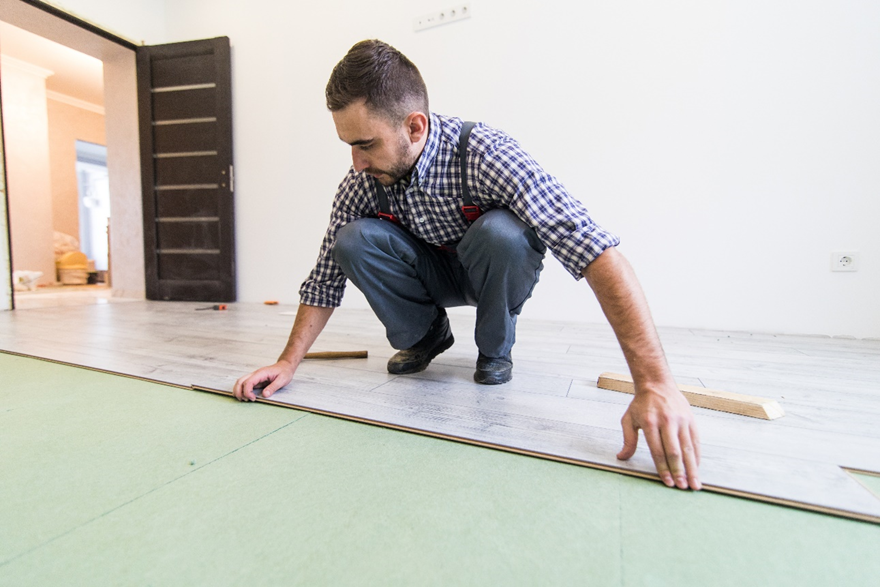You may have heard of laminate flooring when looking for the ideal kind of flooring to match your space. Because of their attractive appearance, the laminate floor has captured thousands of consumers' attention.
Enhancing your home or office with a laminate floor is a fairly smart option. It will help you change the entire appearance by providing durability and a wide choice of style alternatives at budget-friendly costs.
However, sometimes choosing the right flooring can be challenging due to so many options available in the market. When purchasing laminate flooring, a range of finishes needs to be considered, such as the type, thickness, and installation method.
This guide will help you to choose laminate flooring that's right for your home or workplace.
Laminate is a versatile and popular flooring option. Laminate flooring is a synthetic product that replicates the look of natural materials such as hardwood, stone, or tile. It is composed of multiple layers, including a wear layer, a high-resolution image layer, and a core layer made of composite materials. Laminate flooring offers a wide range of benefits, including affordability, durability, and ease of installation. With its realistic designs, low maintenance requirements, and cost-effectiveness, laminate flooring has become a preferred choice for homeowners and commercial spaces alike. This guide will explore the features, advantages, and design possibilities of laminate flooring, and let us assist you in finding the perfect option to enhance your living or working space.
What is Laminate Flooring Made Of?
Although laminate flooring shares a similar overall architecture, they contain a variety of material layers.
Wear Layer: The topmost layer of laminate flooring is the wear layer, which is designed to protect the flooring from scratches, stains, and fading. It is typically made of a clear, strong, and transparent melamine resin that shields the floor from everyday wear and tear.
Design Layer: Beneath the wear layer lies the design layer. This layer features a high-resolution photographic image that replicates the look of natural materials such as hardwood, stone, or tile. Advanced printing technology allows for a wide variety of realistic and visually appealing designs.
Core Layer: The core layer is the backbone of laminate flooring and provides stability and structural integrity. It is typically made of high-density fiberboard (HDF) or medium-density fiberboard (MDF). HDF is denser and more durable, making it a common choice for laminate flooring.
Backing Layer: The bottommost layer, known as the backing layer, provides additional support and stability to the laminate flooring. It helps to resist moisture from the subfloor and prevents the floor from warping or buckling. The backing layer is often made of melamine or a moisture-resistant material.
Together, these layers create a durable and visually appealing flooring option that can withstand everyday use. Laminate flooring offers the beauty and elegance of natural materials while providing the benefits of easy maintenance and affordability. It is an excellent choice for homeowners and commercial spaces seeking a versatile and cost-effective flooring solution.
Types of Laminate Flooring
Laminate flooring offers a wide variety of options to suit different styles, preferences, and budgets. Understanding the different types of laminate flooring can help you find the perfect fit for your space. Explore the following types of laminate flooring available at Riemer Floors:
- Wood-Look Laminate: This type of laminate flooring replicates the appearance of natural hardwood. It offers a wide range of wood species, grain patterns, and finishes, allowing you to achieve the desired aesthetic of hardwood floors without the cost and maintenance associated with real wood.
- Tile-Look Laminate: Tile-look laminate flooring mimics the look of various types of tiles, including ceramic, stone, or marble. It offers the beauty of tile flooring with the added benefits of laminate, such as affordability, durability, and ease of installation.
- Stone-Look Laminate: Stone-look laminate flooring captures the elegance and texture of natural stone, such as slate, travertine, or granite. It provides a realistic appearance while offering the advantages of laminate, including greater affordability and easier maintenance compared to natural stone.
- Embossed or Textured Laminate: Laminate flooring can come with embossed or textured surfaces that add depth, dimension, and authenticity to the flooring. Embossed laminate can imitate the feel of wood grain or natural stone textures, providing a more realistic and tactile experience.
Differences Between Laminate and Luxury Vinyl Flooring
Laminate flooring is a versatile and cost-effective option that offers several advantages over luxury vinyl flooring. Here are some key differences to consider when choosing between laminate and luxury vinyl:
Composition: Laminate flooring is composed of multiple layers, including a wear layer, a design layer, a core layer, and a backing layer. Luxury vinyl flooring, on the other hand, consists of layers such as a wear layer, a photographic layer, and a backing layer. The composition of laminate flooring provides enhanced durability and stability.
Aesthetic Appeal: Laminate flooring offers a wide range of realistic designs that replicate the look of natural materials like hardwood, stone, or tile. It provides a convincing appearance of these materials at a more affordable price point compared to luxury vinyl. Laminate flooring also offers options with embossed or textured surfaces, adding depth and authenticity to the flooring.
Water Resistance: While laminate flooring is highly durable and can withstand everyday spills, it is not as water-resistant as luxury vinyl flooring. Luxury vinyl flooring has superior water resistance, making it a suitable choice for areas prone to moisture such as kitchens, bathrooms, and basements.
Installation: Laminate flooring is known for its ease of installation, often utilizing a click-lock system that allows for straightforward and efficient installation without the need for adhesives. Luxury vinyl flooring also offers similar installation methods. However, laminate flooring may be easier to install for DIY enthusiasts due to its simple installation process.
Comfort: Laminate flooring provides a solid and authentic feel underfoot. It offers a firm surface that is similar to hardwood flooring. Luxury vinyl flooring, on the other hand, provides a softer and more cushioned feel, making it more comfortable to walk or stand on for extended periods.
Price: Laminate flooring is often more budget-friendly compared to luxury vinyl. It provides an affordable alternative to natural materials like hardwood or stone while still offering a similar aesthetic. Laminate flooring offers excellent value for those looking to achieve a high-end look without breaking the bank.
Things to Look Out for When Buying Laminate Flooring
When buying laminate flooring, there are several important factors to consider in order to make an informed decision. Here are the top things to look out for or consider:
Quality and Durability
Opt for high-quality laminate flooring that is built to withstand daily wear and tear. Look for products with a durable wear layer and a thick core layer, as these contribute to the overall durability and longevity of the flooring.
Thickness
Consider the thickness of the laminate flooring. Thicker laminate tends to be more durable and can better withstand impacts and foot traffic. A thickness of 8mm or more is generally recommended for residential use.
AC Rating
Check the AC rating of the laminate flooring. This rating indicates the product's resistance to abrasion, stains, impact, and other factors. Higher AC ratings (ranging from AC1 to AC5) are suitable for different levels of foot traffic, with AC3 or higher recommended for residential use.
Design and Aesthetic Appeal
Laminate flooring offers a wide range of designs, colors, and textures. Choose a style that complements your interior décor and personal preferences. Consider the authenticity of the wood or stone look, as well as the embossing or texturing for a realistic appearance.
Water Resistance
If you plan to install laminate flooring in areas with moisture or high humidity, consider the water resistance properties of the product. Look for options with features like water-resistant cores or moisture-locking systems, which can provide better protection against water damage.
Installation Method
Determine whether the laminate flooring utilizes a click-lock or glue-down installation system. Click-lock systems are popular for their ease of installation and allow for a floating floor, while glue-down options provide a more permanent and secure installation.
Warranty
Check the warranty offered by the manufacturer. Look for products with comprehensive warranties that cover issues such as wear, staining, and water damage. Be sure to understand the terms and conditions of the warranty before making a purchase.
Budget
Consider your budget and look for laminate flooring options that offer the best value for your money. While affordability is a key advantage of laminate flooring, it's important to balance cost with quality and durability.
By considering these factors, you can confidently select the right laminate flooring that meets your needs in terms of aesthetics, durability, and budget. Our knowledgeable team at Riemer Floors is here to guide you through the selection process, providing expert advice and a wide range of laminate flooring choices. Visit our showroom or contact us today to explore the possibilities and find the perfect laminate flooring for your space.


